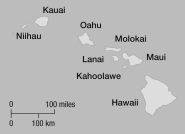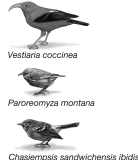Alison Boyer (2008) analyzed data on the extinction of native birds in the Hawaiian Islands, particularly looking at extinctions resulting from two waves of human colonization. How did the patterns of extinction differ? A
B
C
D
A) The first wave of human colonization resulted in the extinction of large, flightless ground-nesting birds as a result of introduced predators, while the second wave resulted in the extinction of birds that fed on insects and nectar due to destruction of lowland forests.
B) The first wave of human colonization resulted in the extinction of birds that fed on insects and nectar due to destruction of lowland forests, while the second wave resulted in the extinction of large, flightless ground-nesting birds as a result of introduced predators.
C) In both waves of colonization, habitat destruction was responsible for the extinction of native Hawaiian birds, with large, flightless birds going extinct in the first wave and birds that eat insects and nectar going extinct after the second wave.
D) The first wave of human colonization resulted in the extinction of large, flightless ground-nesting birds as a result of hunting, while the second wave resulted in the extinction of birds that fed on insects and nectar due to destruction of lowland forests and introduced predators.
Correct Answer:
Verified
Q21: Explain how the figure suggests that extinction
Q22: What does this figure tell about the
Q23: The history of life on Earth as
Q24: You are a paleontologist studying the fossil
Q25: What effect of mass extinctions is described
Q27: Yellowstone National Park in the United States
Q28: Why was the near extinction of all
Q29: Leigh Van Valen (1973) tested the relationship
Q30: The earliest Homo sapiens fossils are about
Q31: The K-Pg extinction was likely the result
Unlock this Answer For Free Now!
View this answer and more for free by performing one of the following actions

Scan the QR code to install the App and get 2 free unlocks

Unlock quizzes for free by uploading documents